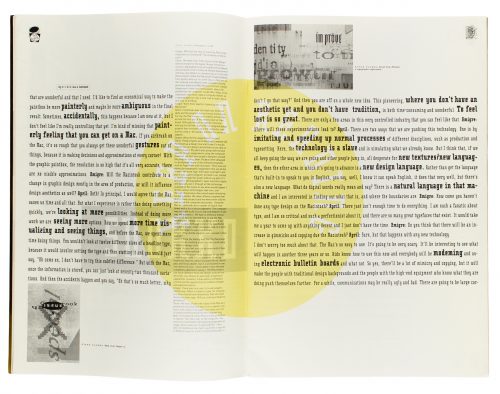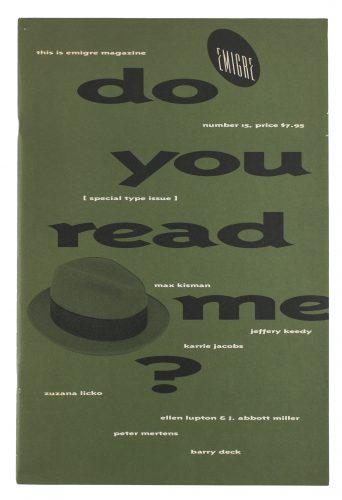An exhibition in the Department
12 June – 14 July 2017
Emigre magazine, co-founded in California in 1984 by Rudy VanderLans, was a provocative and highly adventurous fusion of self-publishing, critical writing and experimental typography. This exhibition investigates a key period in the development of graphic design as a form of authorship and shows how Emigre’s page designs and typefaces embodied new thinking about the designer’s role in communication.

Interviews with April Greiman and Glenn Suokko in Emigre 11, ‘Ambition/fear’, 1989. The early issues of Emigre coincided with the adoption of Macintosh computers by graphic designers. Emigre 11 is devoted to a series of interviews with designers about the new tool. The magazine’s pages often offered multiple reading paths.
With an initial print run of 3,000–5,000 copies, the magazine was supported by a design studio, Emigre Graphics, and by a digital type foundry led by VanderLans’ partner Zuzana Licko. Emigre published 69 issues in a range of formats, from tabloid to paperback book, before closing in 2005, and it was probably the most admired, influential and criticised design magazine of its era.

Emigre 15 cover, ‘Do you read me?’, 1990. This issue, focused on new typefaces and legibility, features typeface designs and interviews with Peter Mertens, Zuzana Licko, John Downer, Jeffery Keedy and Barry Deck, among others.
In the 1990s, the idea that graphic design could be a form of authorship was the focus of intense debate among designers. VanderLans created a vital forum for discussion during a period of rapid change and Emigre’s design and content inspired an international network of visual communicators. The magazine was an era-defining example of entrepreneurial design authorship, which still has lessons for self-publishers today, and a platform where designers could explore the relationship of writing and design.
The exhibition, co-curated by MA Book Design student Francisca Monteiro and Prof. Rick Poynor, draws from the University of Reading’s Special Collections and Rick’s personal collection. The display is divided into sections that reflect the range of Emigre’s activities:
Rudy VanderLans as editor
The Emigre type foundry led by Zuzana Licko
VanderLans as a graphic author
The Emigre Music record label
Emigre as a space for collaborative authorship for designers and writers
Emigre considered in context


